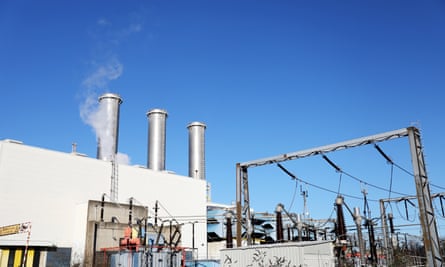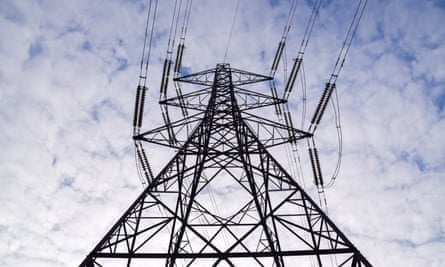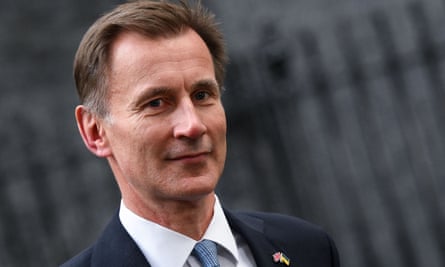At the entrance to the old munitions factory, a pair of ornamental lions stand guard, each with a stone paw resting on a cannonball. The Coryton complex in Essex dates back to 1895, and its use has changed over the years. Behind the lions loom the grey girders of a gas-fired power plant capable of generating electricity for up to 800,000 homes – and substantial profits for its owner.
Debate is raging over the role of gas-fired electricity in the energy crisis. Coryton is one of a fleet of UK peaking plants, so-called because they tend to be fired up at peak consumption times, a backstop when other contributors to the grid, such as windfarms, underperform. But they also attract some of the highest rates per megawatt hour (MWh) of any power source, and those rates have jumped with the gas price since the invasion of Ukraine,leading to calls for their profits to be capped.
Another source of controversy is that unlike oil and gas extraction, peaking plant income is not subject to the government’s windfall tax.
The design of Britain’s energy market is under scrutiny as never before, as efforts to decarbonise collide with a need to keep the lights on during the Russian-inflicted gas shortage.
Ofgem will soon publish proposals designed to prevent backup generators from raking in “excessive” profits as part of their licence conditions. Supporters argue they are an essential rapid source of electricity supplies, and cannot be relied upon to produce reliable profits; detractors say they are owned by sophisticated traders maximising returns when the market is tight.
Last month National Grid paid a record £27m on a single day to get power stations to crank up supply at short notice, including £6,000 a MWh to fire up Rye House power station in Hertfordshire.

Rye House belongs to VPI, a subsidiary of the Swiss trading multinational Vitol. Like many other peaking plants, it has passed into the hands of overseas investors as some of the biggest UK operators have exited the market.
Coryton was owned by InterGen until last week. It now belongs to the Czech financier Pavel Hubáček’s Creditas investment group, which bought it from another Czech businessman and China Huaneng and Guangdong Energy.
Yet another Czech billionaire, Daniel Křetínský, owns EP UK Investments, which has a power plant collection that includes South Humber Bank and Langage – formerly owned by Centrica. Known as the Czech Sphinx for his aversion to publicity, Křetínský has varied UK interests, including stakes in Sainsbury’s and Royal Mail.

Prices paid for gas-powered electricity this winter are unprecedented. The average offer price for “balancing actions” – to align supply and demand – between the start of September and early January was £287 a MWh. Data from Elexon, which oversees the market, shows Rye House submitted the 20 highest winter bids – between £5,000 and £6,000 a MWh – for varying volumes of power on 12 December, setting new records. That day, VPI earned more than £11m, while InterGen received an estimated £12.6m from Coryton, according to figures from the market data platform EnAppSys.
InterGen said a rise in demand had produced a “particularly pronounced spike” on 12 December, and that it always acted “in line with regulations and guidance issued to the market, to provide energy to balance the grid and keep the lights on across the UK”.
Among the other plants bidding above-average winter prices were Uniper’s Ratcliffe-on-Soar coal-fired plant in Nottinghamshire and its gas power station Killingholme in north Lincolnshire, as well as Dinorwig, a pumped hydroelectric power plant in north Wales that is majority-owned by the French multinational Engie and is the fastest source of electricity in the UK.
Cowes power station on the Isle of Wight and the Didcot plant in Oxfordshire both bid at £1,500 for small volumes in October.
Controversially, none of these profits have been subject to the windfall tax introduced by Rishi Sunak when he was chancellor and expanded under Jeremy Hunt.
Companies House records showed VPI Holding’s pre-tax profits surged from £44m in 2020 to £204m in 2021, on turnover that more than doubled to £2.1bn. Reuters reported in September that Vitol made more profit in the first half of 2022 than in the whole of 2021 – close to $4.5bn (£3.6bn), compared with a net record of just over $4.2bn in the 12 months before.

The ‘electricity penalty shootout’
The country’s electricity supply industry is a complex jigsaw puzzle designed to encourage the generation of everything from wind, solar and nuclear power to biomass and gas-fired.
Underpinning this is the “balancing market”, operated in effect by National Grid, which relies on offering the right prices to incentivise power plants to help balance supply and demand. Last winter, the network operator tripled its spend on balancing the grid to £1.5bn.
The system is designed to prioritise renewable electricity ahead of nuclear, coal and gas.
The electricity price in every half-hour period is set by the marginal cost of the last generating unit to be turned off to meet demand – usually gas-fired plants, which have the highest costs. While gas prices were low, there were few objections to this system, but the energy crisis has triggered repeated calls for gas and electricity pricing to be delinked.
The supplier Good Energy draws the analogy with a penalty shootout in football: the best players (renewables) are selected first “but it’s the individual who steps up last who has the final say, deciding the fate of the result” – in this case, the cost.
Gas-fired power still plays a significant role in Britain’s electricity makeup, accounting for 38% of generation last year – a three-year high as the single largest source of power and well ahead of a record 25.6% for wind. If peaking plants are used regularly, their role could be seen more as “baseload” than backup power.
There are concerns about the tactics used by some generators. The energy regulator Ofgem said in November that last winter some generators had declared their plants unavailable to the grid, before later offering power at much higher prices.
In 2020, Ofgem required InterGen to pay £37m after concluding that it “sent misleading signals to National Grid in 2016 about how much energy it would supply during peak winter hours to make a substantial profit”. The regulator found InterGen made £12.8m through “manipulation of the market”. At the time, the company said: “We deeply regret and sincerely apologise for the behaviour of former traders.”
VPI said any suggestion it had made excessive profits was “not accurate” and that it operated “within the rules of the energy market”. It said peaking plants operated “less frequently, with costs to generate and pricing dependent on market conditions”. A spokesperson added: “VPI has invested to almost triple its generation capacity in the last two years and revenue has grown as a result.”

Left out from the levy
When Hunt extended the windfall tax last year from oil and gas producers to the excess profits from nuclear, solar and wind, he exempted gas peaking plants, warning of “unintended impacts” amid fears European gas supplies could fall short of demand, leading to blackouts.
ScottishPower’s chief executive, Keith Anderson, condemned the decision. “The crisis has been made by gas and paid for by renewables,” he said, adding that it was “strange” for government to “cap the price of low-carbon generation and to leave gas generation untouched”.
But Tom Glover, the UK country chair of RWE, which owns several gas-fired stations, said they could go for many years without making enough profit.
“It’s important that when prices improve and allow them to make higher returns they are able to keep that profit so that they are incentivised to keep these power stations open during lower priced periods. These stations are like insurance policies for the whole market,” he said.
A lengthy process designed to deink the price of electricity from gas has begun. Before that, authorities will have to decide whether to act or to stomach peaking plants making significant – if unpredictable – profits.












